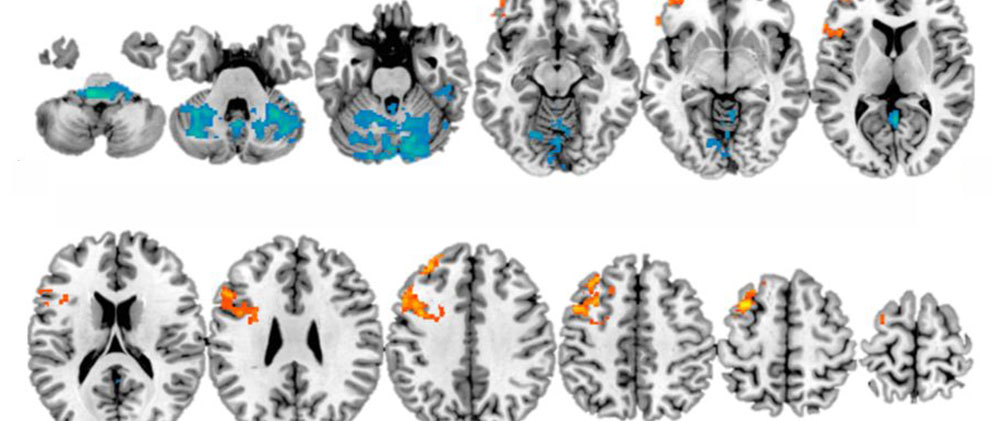Finding Behavioral and Neural Signatures for Collective Creativity in Groups
From The Theme
KNOWLEDGE WORKER PRODUCTIVITY
WHAT IF
What if we could identify and measure the brain basis of creativity, and use those insights to foster creativity and productivity in teams, groups and organizations?
WHAT WE SET OUT TO DO
We set out to assess the behavioral and neural signatures of creativity. We aimed to measure the neural correlates of spontaneous improvisation and figural creativity in healthy adults using multimodal functional neuroimaging. Our research design involved recording participants brain activity as they engaged in word drawing and guessing tasks.
WHAT WE FOUND
The parametric fMRI approach revealed two main insights. First, word-drawing difficulty (as evaluated by the participants) was positively associated with activation in the left pre-frontal cortex, an executive-function center involved in attention and evaluation. At the same time, increased creativity ratings (as evaluated by experts) were associated with higher activation of the bilateral cerebellum, a structure located in the back of the brain and more typically thought of as the body’s movement coordination center, rather than an area important to creativity. Further, our data suggests that activation of the brain’s executive-control centers can be negatively associated with creative task performance. Altogether, our results indicate that spontaneous improvisation and figural creativity is facilitated by interaction between the cerebellum and the cerebral cortex.
LEARN MORE
Read The Published Paper from PNAS
Saggar, M., Quintin, E.-M., Kienitz, E., Bott, N. T., Sun, Z., Hong, W.-C., … Reiss, A. L. (2015). Pictionary-based fMRI paradigm to study the neural correlates of spontaneous improvisation and figural creativity. Scientific Reports, 5(MAY), 10894. JOUR.
Kienitz, E., Quintin, E.-M., Saggar, M., Bott, N. T., Royalty, A., Hong, D. W.-C., … Reiss, A. L. (2014). Targeted intervention to increase creative capacity and performance: A randomized controlled pilot study. Thinking Skills and Creativity, 13, 57–66.
Bott, N., Quintin, E.-M., Saggar, M., Kienitz, E., Royalty, A., Hong, D. W.-C., … Reiss, A. L. (2014). Creativity training enhances goal-directed attention and information processing. Thinking Skills and Creativity, 13, 120–128.
Saggar, M., Quintin, E.-M., Bott, N. T., Kienitz, E., Chien, Y.-H., Hong, D. W.-C., … Reiss, A. L. (2016). Changes in Brain Activation Associated with Spontaneous Improvization and Figural Creativity After Design-Thinking-Based Training: A Longitudinal fMRI Study. Cerebral Cortex (New York, N.Y. : 1991), bhw171.
Saggar, M., Chromik, L. C., Royalty, A., Hawthorne, G., & Reiss, A. L. (2016). Developing Novel Neuroimaging Paradigm to Assess Neural Correlates of Improvisation and Creative Thinking Using fMRI (pp. 309–317). Springer International Publishing.
Hawthorne, G., Saggar, M., Quintin, E.-M., Bott, N., Keinitz, E., Liu, N., … Reiss, A. L. (2016). Designing a Creativity Assessment Tool for the Twenty-First Century: Preliminary Results and Insights from Developing a Design-Thinking Based Assessment of Creative Capacity (pp. 111–123). Springer International Publishing.
PEOPLE BEHIND THE PROJECT
 Allan L Reiss is the Howard C. Robbins Professor in the Department of Psychiatry and Behavioral Sciences and Director of the Center for Interdisciplinary Brain Sciences Research (CIBSR) at Stanford University School of Medicine. Dr. Reiss uses advanced research methods and tools such as neuroimaging, genetic analyses and neurobehavioral assessment to focus on neurodevelopmental and neurogenetic disorders of childhood onset. In particular, he studies how genetic and environmental factors affect brain structure and function, and how this ultimately impacts the development and function of persons with these disorders
Allan L Reiss is the Howard C. Robbins Professor in the Department of Psychiatry and Behavioral Sciences and Director of the Center for Interdisciplinary Brain Sciences Research (CIBSR) at Stanford University School of Medicine. Dr. Reiss uses advanced research methods and tools such as neuroimaging, genetic analyses and neurobehavioral assessment to focus on neurodevelopmental and neurogenetic disorders of childhood onset. In particular, he studies how genetic and environmental factors affect brain structure and function, and how this ultimately impacts the development and function of persons with these disorders
 Manish Saggar is Assistant Professor in the Department of Psychiatry & Behavioral Sciences at Stanford University, and Faculty Member at the d.school. Dr. Saggar is the Principle Investigator at the Brian Dynamics Lab at Stanford University, a computational neuropsychiatry lab dedicated to developing computational methods for a better understanding of individual idfferences in brain functioning in healthy and patient populations. Dr. Saggar’s research focuses on the intersections of cognitive science, neuroimaging, and computational modeling. Dr. Saggar holds a PhD in Computer Science from the University of Texas at Austin.
Manish Saggar is Assistant Professor in the Department of Psychiatry & Behavioral Sciences at Stanford University, and Faculty Member at the d.school. Dr. Saggar is the Principle Investigator at the Brian Dynamics Lab at Stanford University, a computational neuropsychiatry lab dedicated to developing computational methods for a better understanding of individual idfferences in brain functioning in healthy and patient populations. Dr. Saggar’s research focuses on the intersections of cognitive science, neuroimaging, and computational modeling. Dr. Saggar holds a PhD in Computer Science from the University of Texas at Austin.
 Malte Jung is an Assistant Professor in Information Science at Cornell University. His research focuses on the intersections of teamwork, technology, and emotion. The goal of his research is to inform our basic understanding of technology supported teamwork as well as to inform how we design technology to support teamwork across a wide range of settings. He received his Ph.D. in Mechanical Engineering and his Ph.D. minor in Psychology from Stanford.
Malte Jung is an Assistant Professor in Information Science at Cornell University. His research focuses on the intersections of teamwork, technology, and emotion. The goal of his research is to inform our basic understanding of technology supported teamwork as well as to inform how we design technology to support teamwork across a wide range of settings. He received his Ph.D. in Mechanical Engineering and his Ph.D. minor in Psychology from Stanford.
